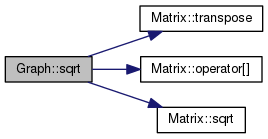The graph of a function. More...

Public Member Functions | |
| virtual double | getSum () |
| Sum of elements. More... | |
| Graph & | multiply (double d) |
| Multiply with a scalar. More... | |
| Graph & | add (double d) |
| Add a scalar. More... | |
| Graph & | exp () |
| Exponential. More... | |
| Graph & | sqrt () |
| Sqare root for each element. More... | |
| Graph & | integrate () |
| Integrate. More... | |
| Graph & | differentiate () |
| Differentiate. More... | |
| Graph & | inverse () |
| Calculate the inverse. More... | |
| void | sortX (int start=0, int end=-1) |
| Sort the points according to the x values. More... | |
 Public Member Functions inherited from Matrix Public Member Functions inherited from Matrix | |
| Matrix () | |
| default constructor: constructs a zero-dimensional matrix (a scalar). | |
| Matrix (int i) | |
| constructs a one-dimensional matrix | |
| Matrix (int i, int j) | |
| constructs a two-dimensional matrix | |
| Matrix (int i, int j, int k) | |
| constructs a three-dimensional matrix | |
| Matrix (int i, int j, int k, int l) | |
| constructs a four-dimensional matrix | |
| Matrix (int dimensions, int *sizes) | |
| constructs an n-dimensional matrix | |
| virtual | ~Matrix () |
| destructs the matrix | |
| Matrix & | setName (const string &) |
| set name | |
| string | sName () |
| get name | |
| int | nDimension () |
| Get number of dimensions. | |
| int | nSize (int n) |
| Get size for dimension. | |
| Unit | getUnit (int n) |
| Unit of dimension n. | |
| void | setPhysical (int n, Physical p) |
| Set physical dimension of dimension n. More... | |
| void | setPhysical (Physical p) |
| Set main physical dimension. More... | |
| Physical | pPhysical (int n) |
| Get physical dimension for dimension n. More... | |
| Matrix | operator[] (int i) |
| retrieve slices or values More... | |
| Matrix & | remove (vector< int >) |
| remove one or more dimensions More... | |
| void | operator++ (int i) |
| increment a zero-dimensional matrix | |
| void | operator= (double d) |
| assignment More... | |
| Matrix & | operator+= (const Matrix &) |
| addings More... | |
| Matrix | operator() (int i, int j) |
| retrieve ranges - not implemented yet! More... | |
| double | to_d () |
| convert to double More... | |
| double | getMaxValue () |
| get maximal value | |
| double | getMinValue () |
| get minimal value | |
| void | replaceNan (double d) |
| Replaces NaNs. More... | |
| Matrix & | transpose () |
| Transpose matrix. More... | |
| Matrix & | operator= (const Matrix &m) |
| assignment | |
| Matrix (const Matrix &m) | |
| Copy constructor. More... | |
 Public Member Functions inherited from Physical Public Member Functions inherited from Physical | |
| Physical () | |
| Construct. | |
| Physical (const Physical &) | |
| Copy. | |
| Physical (string name) | |
| Construct. | |
| Physical (string name, string unitPrefix, string unitSymbol) | |
| Construct. | |
| Physical (string name, Unit unit) | |
| Construct. | |
| virtual string | getDescription () |
| Retrive the physical name. More... | |
| virtual string | getPhysicalDescription () |
| Returns the physical description. More... | |
| virtual string | getUnitName () |
| Returns the unit name. | |
| virtual string | getUnitSymbol () |
| Returns the unit name. | |
| virtual void | setDescription (string name) |
| Set the name. More... | |
| virtual void | setPhysicalDescription (string name) |
| Set the name. Same as setDescription(). More... | |
| virtual void | setUnit (Unit u) |
| Set the unit. | |
| virtual void | setUnitPrefix (int n) |
| Set unit prefix. More... | |
| virtual Unit | getUnit () const |
| Retrieve the unit. | |
Detailed Description
The graph of a function.
A graph is the set of points p, with p = f(a), a element A, where A is the domain of f. This class is a matrix (containing a numerical representation of the graph) with dimension n+1, where n is the number of inputs to f. It is organized so that file << graph appends gnuplot-plottable matrix notation to 'file'. If used as a matrix, you have (for a function with one parameter) graph[i] is the i'th data point, and graph[i][0] is the input a_i, and graph[i][1] is the output f(a_i). The main difference to the normal matrix class is that all mathematical operations (integrate, differentiate, multiply, etc.) only work on the output values (i.e. on graph[..][1]).
- Todo:
- Only two-dimensional graphs are implemented yet. Change this.
Member Function Documentation
|
inlinevirtual |
Add a scalar.
Adds a scalar to each element of the graph. A reference to the graph itself is returned for convenience, so that you can write things like m.add( a ).multiply( b )
Reimplemented from Matrix.
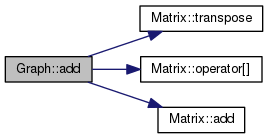
|
inlinevirtual |
Differentiate.
This function differentiates over the last dimension of the graph. A difference-graph is produced, where m'[0] = 0.0, m'[1] = m[1]-m[0], m'[n] = m[n]-m[n-1]. Doing this on an integrated graph, m.integrate().differentiate(), restores the original graph, but m[0] will be lost (set to 0.0).
Reimplemented from Matrix.
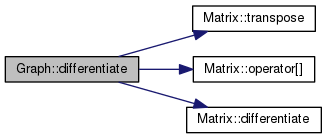
|
inlinevirtual |
Exponential.
Transforms each element into its exponential. A reference to the graph itself is returned for convenience, so that you can write things like m.exp().multipliy( a ).add( b )
Reimplemented from Matrix.

|
inlinevirtual |
Sum of elements.
This returns a sum of all elements.
Reimplemented from Matrix.
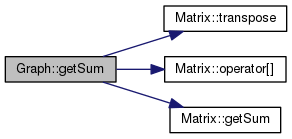
|
inlinevirtual |
Integrate.
This function integrates over the last dimension of the graph. A cumulative sum is produced, where m'[0] = m[0], m'[1] = m[0]+m[1], m'[n] = m[0] + m[1] + ... + m[n]. Doing this on a differentiated graph, m.differentiate().integrate(), retrieves the original graph, shifted so that m[0] = 0.0, and adding the original m[0] restores the original graph.
Reimplemented from Matrix.

|
inline |
Calculate the inverse.
This function just swaps x and y of the graph, and calls sortX() so that all x values are in ascending order afterwards.

|
inlinevirtual |
Multiply with a scalar.
Multiplies the graph with a scalar. A reference to the graph itself is returned for convenience, so that you can write things like m.multipliy(3).add(4)
Reimplemented from Matrix.
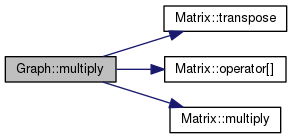
|
inline |
Sort the points according to the x values.
This function is used by the inverse() function, after swapping x and y. It sorts all points of the graph, so that the x values of all points will be in ascending order. The currently implemented method is merge sort.

|
inlinevirtual |
Sqare root for each element.
Transforms each element into its square root. A reference to the graph itself is returned for convenience, so that you can write things like m.sqrt().multipliy( a ).add( b )
Reimplemented from Matrix.
